AGAVOIDES 'Prolifera' 아가보이데스 '프로리페라' (Walther) Kimnach, 1998 (engl./ fr.)
Synonym : Echeveria agavoides var. prolifera Walther (1972)
Etymology : The name refers to the numerous proliferous offshoots emitted by each rosette.
Type : CAS 304230 from plant grown in Golden Gate Park, San Francisco, originally from the garden of C. Halbinger, Mexico City.
Distribution : Only known from cultivated plants in the garden of C. Halbinger, Mexico City; probably a hybrid.
Description by E. Walther as E. agavoides var. prolifera (Echeveria, 84,1972) :
Plants glabrous.
Rosettes to over 25 cm in diameter, stemless but usually freely offsetting.
Leaves numerous and crowded, to 30 or more in each rosette, 10 – 12 cm long, to 30 mm wide, turgid, subtriquetrous, oblong-oblanceolate, nearly flat above, acuminate-aristate, ascending, colour pale dull green-yellow.
Inflorescences three or more, peduncle slender, spreading to ascending, to over 15 cm long, carmine, bracts few, appressed, linear-lanceolate, acuminate, 6 – 8 mm long, brown, branches usually three, secund-racemose, with eight or nine flowers each, pedicels slender, to 10 mm long, not turbinate.
Flowers : Sepals very unequal, deltoid to ovate, acute, slightly connate at base, spreading, corolla narrowly urceolate, to 16 mm long, rose-doree to peach-red above, inside capucine-orange, carpels yellow, styles yellowish-green, neactaries rather broad, obliquely truncate, to 2 mm wide, light yellow.
Flowering time from April on.
Distributed as ISI 321 : “…. This is much larger than the typical variety; the rosettes may reach 1’ in diameter, but remain small if under potted. The leaves though not margined with red, become suffused with a deep pinkish colour in sunlight.”
Note :
E. agavoides 'Prolifera' differs from E. agavoides by offsetting freely, having more leaves and sepals only slightly connate at the base. It differs from E. agavoides 'Corderoyi' by its narrower leaves and a longer corolla (16 mm). It is resembling E. 'Gilva' and van Keppel suggests that it is likely to be a hybrid, too.
In any case, Walther's description is in fact of no use because it was made from a plant of unknown origin which has never been found in the wild and may even have been a hybrid.
-------------------------------------------------------------------------------------------------
유통 : 멕시코 시티의 C. Halbinger 가든에서 육종되었다는 점만 알려져 있다. 아마도 교배종일 것이다.
서술( 1972년, Echeveria, E. Walther에 따르면)
털이 없는 반들반들한 식물이다.
로제트는 직경 25 cm 이상이며, 줄기는 없지만 보통은 자구를 갖기도 한다.
잎은 로제트 당 30개 이상으로 많고 빽빽하며, 길이는 10 – 12 cm 폭은 30 mm 이며, 횡단면이 삼각형태로 부풀어 오른 듯 하며, 기다란 도피침형이며, 윗면은 거의 평편하고, 잎 끝 쪽으로 갈수록 뾰족하고 날카로우며, 엽색은 연하면서 흐릿한 그린-옐로우이다.
꽃차례는 3개 이상이며, 꽃줄기는 가늘고 위로 갈수록 벌어지며, 길이는 15 cm 이상이고 회색빛이 도는 빨강색이며, 포엽은 거의 없고 바짝 달라붙은 선상피침형이고 뾰족하고 길이는6 – 8 mm 이며, 꽃줄기는 보통 3개이고 각각 8 – 9개의 꽃을 지닌 겹총상꽃차례이며, 작은 꽃자루는 가늘고 길이는10 mm 이고 나선형태는 아니다.
꽃 : 꽃받침은 매우 불균일하고 삼각형에서 달걀형, 첨두형으로 기저부에서는 약간 붙어 있지만 갈라진다. 꽃잎은 좁은 단지형이고 길이는 16 mm 이고 장미빛-금빛이고 윗부분은 복숭아빛-붉은색이고 안쪽은 카푸신느-오렌지빛이다.
이 식물은 전형적인 품종보다 더 대형종이다. 로제트는 직경 1피트에 다다를 수 있다. 그렇지만 화분에 심겨져 있을 때는 작아 질 수 있다. 입은 붉은 테두리를 갖지 않지만 좋은 햇볕에서는 진한 핑크빛으로 물든다.
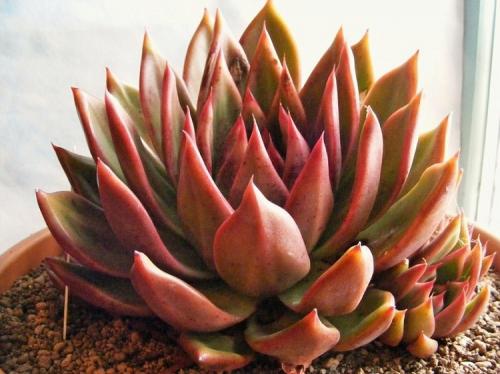
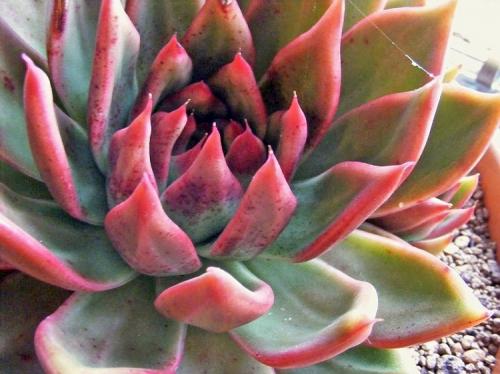
Echeveria agavoides 'Prolifera' ISI 321
Photos Mike Ambler
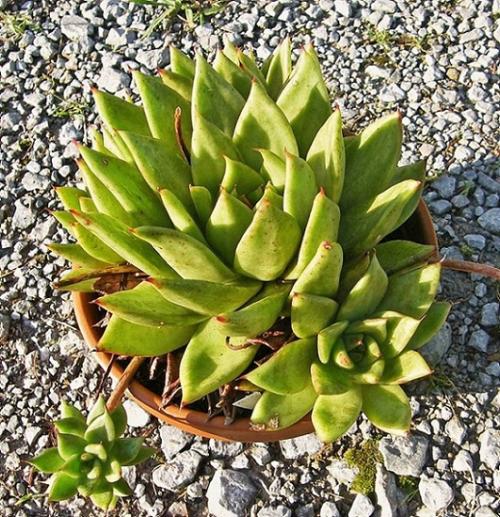
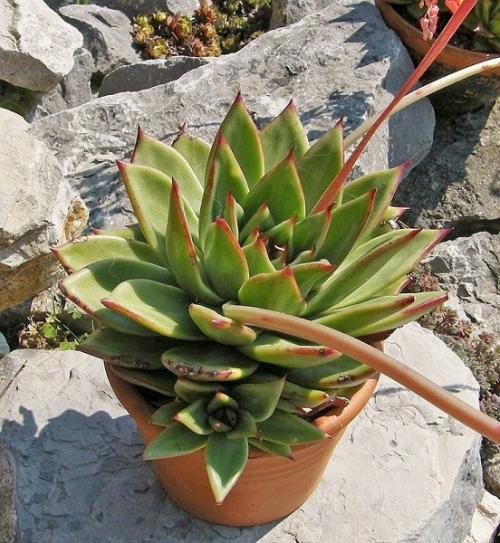
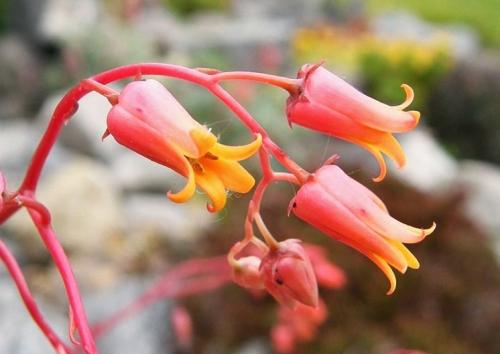
At Huntington Botanical Gardens :
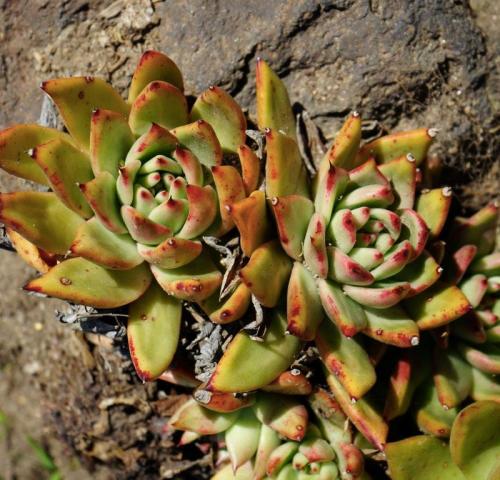
Photo Eria Wei